15 Fascinating Facts in the World of Cheese
With so many cheeses available around the world it is not surprising that
there is sure to be a type of cheese you will enjoy. There is a huge
number of types and flavors that are available. Most cheese lovers have
favorites as well as favorite ways to eat them but not many know the history or
how many different varieties there really are. The sheer volume of cheese
consumed each year is what makes it such a global phenomenon.

Depending on how it's made, cheese can take on a variety of flavors. There
are some cheeses that are flavored with dried fruit or even honey. Cheese
artisans create different combinations of flavors to tease and titillate the
palate. In Wisconsin, they mixed sweet, tart cranberries with smoky chipotle to
create a cheese that tastes a little like barbecue sauce. There is even an aged
goat cheese rubbed with cocoa powder. For libation lovers, cheese is paired with
wine, liquor or even beer. One cheese maker creates a cider soaked cheese with
reddish-brown veins.
This hunt for flavor goes back all the way to olden days when cheese was
smoked with fruits such as apples to give it some added dimension. Whatever the
method, cheese inspired creativity, which led to thousands of distinctions and
millions of cheese lovers. Over the course of history, Europeans have refined
the art of cheese making and even cheese consumption. Cheese is eaten with most
meals if not all meals. It can be the center of a dish, served as dessert when
combined with certain fruits, or a quick snack on the go. It really is one of
the most versatile foods in the world.
15) Casu Marzu Cheese
When it comes to cheese, most people are aware that it is the fermented form of
milk. However, there is one cheese that takes the process one step further to
the decomposition stage and that's Casu Marzu cheese. This sheep's milk cheese
is considered to be an aphrodisiac and is native to Sardinia, an island off the
coast of Italy between Corsica and Sicily.
Casu Marzu is made when pecorino cheese is left out with a piece of the rind
missing. This encourages Piophila casei, the cheese fly, to lay its eggs in the
cheese. These eggs hatch and the larvae eat their way through the cheese. Their
digestive acids break down the fats of the cheese making it soft and spreadable.
In Sardinia, it's eaten with a piece of moistened flatbread. The cheese fly lays
thousands of eggs so by the time Casu Marzu is ready to be eaten by humans,
there are thousands of maggots in the cheese.
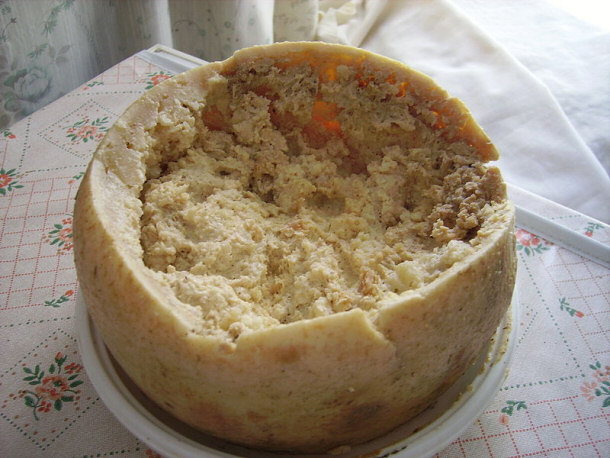
By Shardan (Own work) [CC-BY-SA-2.5],
via Wikimedia Commons
The funny thing about Casu Marzu is that it is considered safe to eat only
when the maggots are alive and active within the cheese. Placing the cheese in
the fridge kills the maggots in the cheese and renders Casu Marzu unsafe for
consumption. The translucent white larvae are one third of an inch long and can
jump up to 6 inches. It's not unusual for them to jump off the bread as its
being spread. Those who want to eat the cheese and not the maggots can put the
cheese in a sealed bag. The act of depriving the maggots of air agitates them
and makes them jump off the cheese into the bag. The process is similar to
popping corn so when the popping sound lessens or stops, most if not all of the
maggots have jumped out of the cheese.
For many years it was considered illegal in Europe and was only available on
the black market, sometimes for double the price of pecorino. It wasn't until
the 80's and 90's that it was declared a traditional food and not subject to the
regular hygienic standards of other cheeses. Researchers found a safe method to
create the maggoty cheese while keeping it traditional and it began selling
legally in Europe in 2005.
14) Cheese Has Eyes
Swiss cheese is the generic, commercial name given to cheeses produced around
Emmental, Switzerland. The holes in this cheese are called eyes. To make these,
cheese makers use three types of bacteria each from the species of
Streptococcus, Lactobacillus, and Propionibacterium. The propionic bacteria eat
the lactic acid that is produced during the process and it produces carbon
dioxide. This forms the eyes of Swiss cheese. Acetate and propionic acid are
also produced during this process and they are responsible for Swiss cheese's
nutty, sweet flavoring.

When it was first created, the holes were considered imperfections and the
cheese makers tried to avoid them. Now the eyes are considered trademarks of
Swiss cheese. Swiss that has fermented for a long time has larger eyes. While
the flavor is more pronounced it becomes a problem for the industry because
large eyes don't slice well. In 2002, USDA regulators limited the size of the
eye to a maximum of 11/16 of an inch so that the cheese can be sliced properly.
Cheese makers adjusted the temperature and curing time to comply with the new
standard.
13) Cheese Making is
over 7,000 Years Old
The art of cheese making dates back to as early as 5500 B.C. This is significant
because it shows archaeologists that Neolithic farmers were evolving beyond the
roles of hunter and hunted as they were becoming less nomadic.
There were a few cattle-herding sites found in the region that is now Poland
that indicated that cows were not just slaughtered for meat and milk. Farmers
found means to maximize the use of their herds by creating byproducts such as
cheese. Because milk was easily corruptible but an important part of the diet,
finding ways to preserve it became an important part of Neolithic development.
Early humans were lactose-intolerant and naturally made cheese that had less
lactose making it easier to digest.
Over time, farmers found a process to turn milk to an easily digestible form
using certain tools. Specific kinds of milk residue were found in pottery, such
as man-made sieves and strainers indicating that milk was most likely curdled to
form cheese. While dairy farming was present in other sites such as Africa and
areas near Istanbul between the fifth and seventh millennia BC, those sites
showed no evidence of cheese-making.
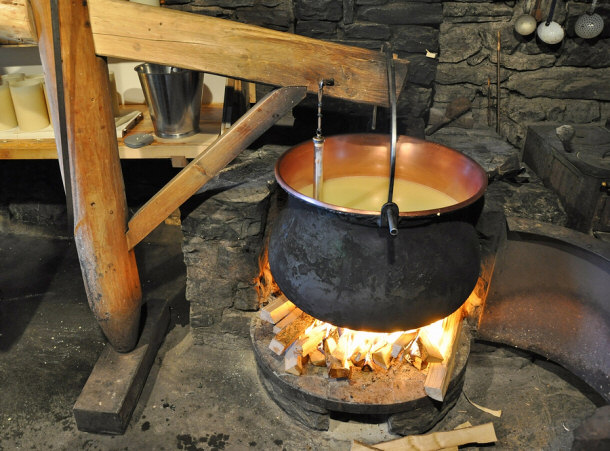
Cheese making eventually made its way to Ancient Egypt. Murals from 2000 BC
demonstrate the making of butter and cheese as well as how they stored milk in
skin bags on poles. Through the spread of the Roman Empire came the refined art
of cheese making. Some Roman houses even had separate kitchens for making cheese
called careale.
Through certain historical writings and references you can trace the art and
influence of cheese making throughout Europe and the Mediterranean. During the
twelfth century BC the writer Homer wrote about a cheese called Cynthos that was
sold by the Greeks to the Romans.
Over a thousand years later during the second century BC, the use of rennet
became a common ingredient in making cheese and cheese was becoming a serious
source of revenue. By fourth century AD, cheese was regularly exported to the
Mediterranean and by the collapse of the Roman Empire, cheese making hit the
coasts of the Adriatic and Aegean as well as Southern and Central Europe.
12) Cheese Eaten by
the Pounds
A study done in 2003 found that Americans were eating an average of 30 pounds of
cheese per person yearly. That equated to nearly nine billion pounds of cheese.
With a population of over 300 million and growing, that could easily pass 10
billion in 2013. California alone produces more than 250 types of cheese, but
the American palate has become desirous of more sophisticated varieties of
cheeses. Not only are they munching on local and farmstead cheeses but they are
also into blue cheeses, mozzarella and other aged gourmet varieties.
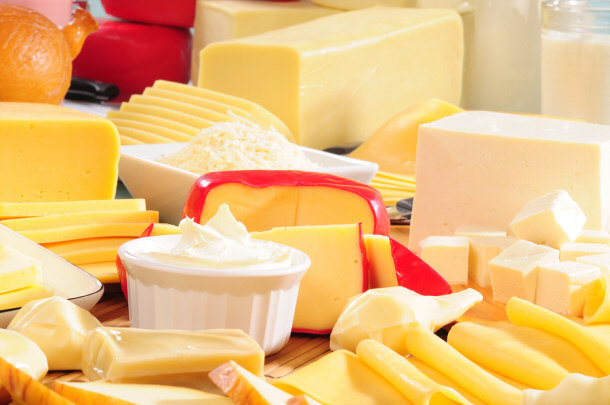
Thirty pounds per person is a lot of cheese but it's no surprise that France
beats the US eating between 20kg and 25kg (45-55 pounds) of cheese, per
person, per year, The history of cheese in France goes all the way back to
European monks in the Middle ages. France has over 360 types of cheese made and
named for different regions and communities in the country. Cheeses in France
are made by a single farm, a co-op of farmers, or commercially produced. Almost
all cheese is regulated by the Appellation d’Origine Protegé (AOP), who
maintains certain standards of cheeses throughout the country.
The Greeks squeak by the French by eating more than 27 kg (60 pounds) of
cheese per year. There are 19 types of Greek cheese that were awarded the
protected designation of origin (PDO) by the European Union that protect the
quality of certain agricultural products. This was done to protect the origin
and representation of a country's national cheeses.
11) Annatto, Natural
Cheese Dye
Annatto seed, also known as achiote, comes from a pod that contains multiple
seeds. It's a seed that is used in Latin American and Caribbean dishes. It has a
sweet, nutty, spicy flavor that imparts a range of color from light yellow to
deep orange. Commercially, it's used to color a variety of foods including
cheese, butter, margarine, smoked fish and others. Traditionally, it's used in
the Spanish dish arroz con pollo to give rice that yellow color.
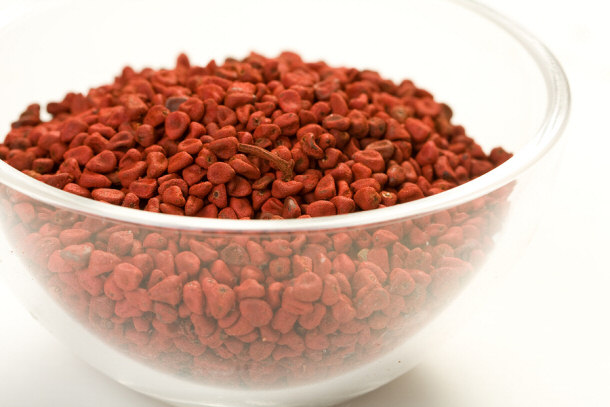
It was used in Gloucester cheese starting in the seventeenth century. During
the summer, the higher carotene levels in the grass would give the milk a
pronounced orange hue, which showed up in cheeses. That coloration became a sign
on top quality cheese and other cheese makers used annatto to replicate the
coloring. The practice spread to cheeses that came from Cheshire, Red Leicester
and even Scotland.
Annatto seeds are rich in antioxidants called tocotrienols. This antioxidant
is similar to vitamin E and is found in other forms of oil. It's the
subject of medical research and trials related to cancer prevention. It's also
used as a treatment for common infections and is considered safe for consumption
by most people.
10) The Most
Expensive Cheese is Not French
In 2004, it was discovered that the most expensive cheese is not made in France
or even Italy but in Sweden. In a town called Bjursholm, Christer and Ulla
Johannson made cheese from their three moose cows, Gullan, Haelga, and Juna,
Between May and September, the cows produce one gallon of milk a day which
yields between 650 to 660 pounds of moose cheese per year.

Milking a moose can take up to two hours because when moose are disturbed,
the milk dries up. That's why moose need to be milked in complete silence. Milk
is curdled just three times a year and with the intensive process of collecting
it as well as the limited supply, the price of moose cheese is about $500 per
pound or $1,000 per kilo.
9) Camel Milk Cheese
In general, a camel can yield between five and twenty liters of milk per day
even without drinking water for nearly three weeks. The problem is that camel
milk doesn't coagulate easily and bovine rennet proved ineffective in the
process. Thanks to technological advances, scientists are able to use vegetable
rennet and camel rennet to curdle the milk and create camel cheese. Currently,
the cheese is only produced and sold in Mauritania. There are restrictions
preventing it from being sold in Europe while supply difficulties make it hard
to manufacture and sell in the U.S.

8) The Story of Blue
Cheese
Blue cheese is a generic term used to describe certain cheeses that have
colorful, distinctive veins of blue or green. These cheeses are inoculated with
varieties of Penicillium and then aged for at least three to five months. The
story behind Blue Cheese involves a young man forgetting his cheese in a cave.
Months later he returns to find the cheese veined and that's how blue cheese was
discovered. These cheeses have no rind and have a distinctively biting flavor.
Roquefort is a type of blue cheese with green veining that was mentioned in
writings as early as 79 AD. It is France's second most popular cheese.
Gorgonzola is a blue veined Italian cheese that's been produced in Gorgonzola,
Milan since the ninth century. Bleu d'Auvergne is a less salty, creamier blue
cheese that's used in salad dressings. Stilton is an English blue cheese that is
used to flavor soups and is eaten with crackers and pears.
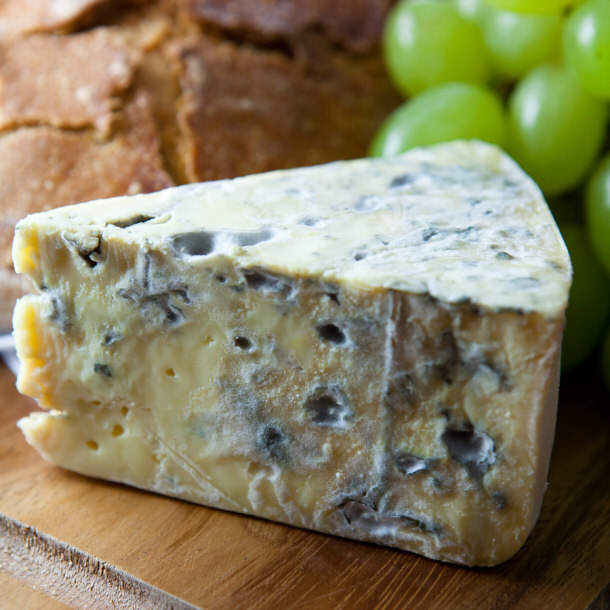
7) Cheese Protects
Teeth
Cheese is a great source of calcium but the benefits go far beyond that. Cheese
actually protects your teeth from tooth decay also known as caries. Teeth go
through a natural cycle where the minerals of the enamel are lost and regained.
This demineralization/re-mineralization process replaces lost calcium with the
help of the saliva. Cheese stimulates saliva production and also clears food
particles from your teeth. After eating most foods, the mouth becomes more
acidic. Teeth are vulnerable to acidity because it erodes enamel so the balance
needs to be restored. Eating cheese counteracts this acidity and balances the pH
of the mouth, preserving your enamel. Phosphorus is the second most abundant
mineral in the body, behind calcium. Both work to build strong teeth as well as
bones. Cheese contains both calcium and phosphorus which protects the enamel and
prevents plaque build-up. Aged Cheddar, Swiss, Gouda, and Blue are some of the
cheeses that reduce tooth decay.

6) The Proper Way
to Eat and Store Cheese
Many people buy cheese, put it in the fridge, and cut it without much thought.
To get the full flavor of cheeses, there are some rules. Slicing cheese is a
necessity but when buying unpasteurized cheese, it shouldn't be pre-sliced or it
will lose a lot of the flavor and aroma. Semi-hard, semi-soft and hard cheese
should be kept between 46-56 degrees and should be taken out anywhere between 30
minutes to two hours before serving so that the flavors develop.
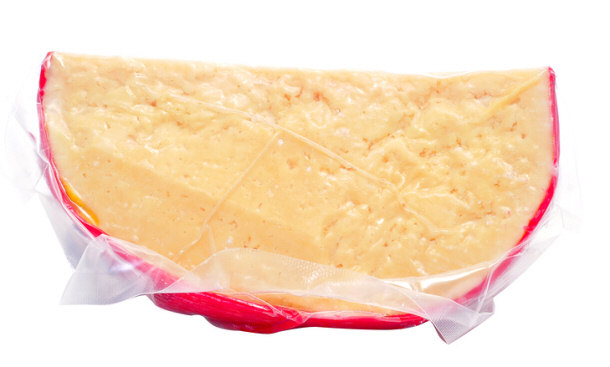
When refrigerating cheese, it shouldn't be wrapped tightly or locked in a
freezer bag. Cheese needs to breath. The best way to help this is to wrap
loosely in wax paper, not clingy plastic wrap. Place it in a loose fitting bag
that will allow humid air to circulate. One of the best places to put cheese is
in the crisper so that it doesn't dry out and become hard. The only exception to
the tight wrapping rule is moldy cheese. They need to be wrapped completely
because their mold spores migrate to anything near it including other food.
Cheese needs to be protected from other strong smelling foods because it will
take on the aroma and may spoil quicker.
5) There are over
2000 varieties of cheese
While there isn't an exact number, the number of cheeses in the world is in the
thousands and can usually be categorized simply.
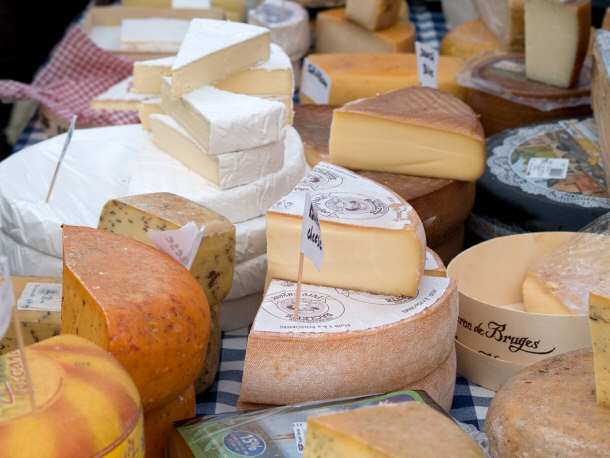
- Fresh cheeses are the simplest forms. They happen when milk is curdled
then drained. They don't have any preservatives and will spoil within days
if not consumed or properly stored. These include cottage cheese,
Mozzarella, and Ricotta.
- Semi-soft cheeses, like Havarti, have a lot of moisture but are bland in
taste.
- Medium-hard cheese is ideal for melting and have sharp flavors. They
have eyes and are great for quick snacks. They include Gruyère, Edam, and
Gouda.
- Semi-hard cheeses have lower moisture and are aged longer. They do go
through some heating and pressing and the flavors of these cheeses are
pronounced. Cheddar is one of the most popular semi-hard cheeses.
- Milk from goats, sheep and other animals such as water buffalo are
commercially available and just as popular. The Greeks make Feta cheese from
sheep's milk and Pecorino Romano is made from goats.
- Soft-ripened cheeses start off chalky and are exposed to mold, such as
Penicillium candida, to create a crust. They are smooth textured with
intense flavors such as Brie and Camembert.
- Washed-rind cheeses are like soft-ripened cheeses but they are cured in
saltwater brine solution, beer, wine, or even brandy. This makes them more
susceptible to Brevibacterium linens, a red-orange colored bacteria that
gives them that pungent odor and flavor. Limburger cheese is a prime example
as it's known for its "stinky" smell and smooth flavor.
- Smear-ripened cheeses are smeared with bacteria or fungi uniformly and
are aged which gives them very strong flavor and aroma. The rinds range from
red to reddish-orange like that of the French cheese, Port Salut.
- Brined cheeses are matured in a salt solution and have no rind because
the salt inhibits bacterial growth. They are mostly white, salty, acidic,
and are produced in the Mediterranean and Middle East where the climate is
hot.
- Processed chesses are made from natural cheese, preservatives, food
coloring and additional milk. It's made for a poor economy and some may be
available in cans.
4) Rennet is
Essential to Cheese Making
Rennet is a group of enzymes that are added to milk to help it to separate into
curds and whey. These are naturally occurring enzymes found in a calf's stomach
and are vital to the cheese making process. The traditional method involves
having the stomachs of young calves dried, cleaned and then used to create a
solution which naturally coagulates milk. The proper concentration of the
solution is added to the milk and the process goes on from there.
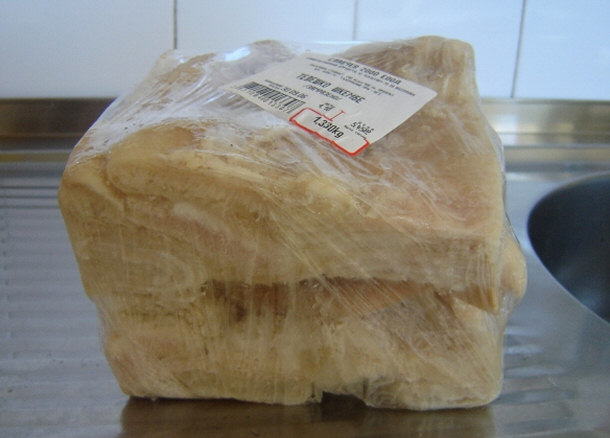
Photo by: Kiril Kapustin
The more modern approach follows the same idea. Calf stomachs are frozen,
milled and then the enzyme is extracted. Acid is added to activate the enzymes
and the rennet is filtered and made ready for use. Since stomach acid is
unavailable, some cheese makers use citric acid to create the reaction.
Because the original form of rennet is in limited supply, there are
alternative forms of rennet made from vegetable and microbial sources.
Scientists found a way to make certain fungi, yeasts, and bacteria ferment to
produce the enzyme chymosin. The process called fermentation-produced chymosin,
(FPC), is used by 80 to 90 percent of manufacturers during the cheese making
process. Because the microorganism is killed during and after fermentations,
chymosin does not contain any genetically modified substances. The fungus
Aspergillus niger and the yeast Kluyveromyces lactis are the most widely used
commercial sources of chymosin. FPC has the distinction of being the first
artificially produced food substance allowed by the U.S. Food and Drug
Administration. Because it is not animal based, FPC is vegetarian appropriate,
certified kosher, and yields cheeses that are less bitter with better texture.
3) The Original
Cream Cheese is Not from Philadelphia
Many people associate cream cheese with the brand Philadelphia and assume that
it is just processed cheese. The truth is cream cheese is derived from
Neufchâtel cheese that dates back to the 16th century French region
Neufchâtel-en-Bray. It was made like many other cheeses, using rennet for
coagulation. It's was then dusted with penicillium candidum, molded, matured,
and manually salted. American cream cheese is an attempt to recreate Neufchâtel
cheese according to multiple reports. The result was a creamier consistency that
was more spreadable and was lower in fat. In the late 19th century, dairyman
William Lawrence purchased the Neufchâtel factory in New York and started mass
producing the cream cheese. It quickly became very popular and in 1880, the
cream cheese company was called Philadelphia.
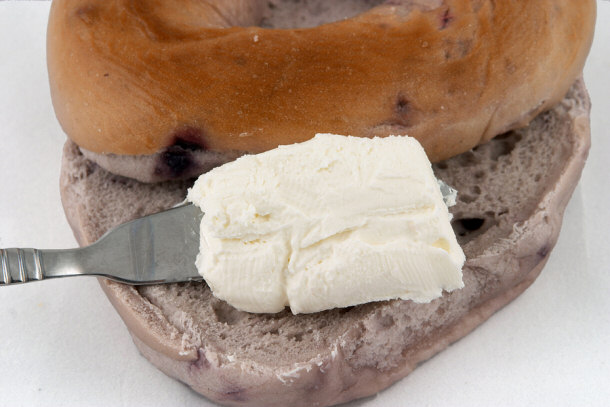
2) Oldest Edible
Cheese
A block of 40 year old cheddar cheese was the oldest edible cheese in the world
in 2012. A Wisconsin cheese maker made batches of cheese decades before and
stored them in the back of his cooler. He then forget about them until he was in
the process of shutting his store. In addition to that block, he found cheese
blocks that were also 34 and 28-years-old. The youngest block of cheese was
tasted and to the surprise of many, it was still creamy. There were these pink
crystals that provided an intense flavor experience when patrons bit into them.
The 40-year-old cheese was a bit more intense. So much so that it was decided
that in order for it to be palatable, it needed to be eaten in smaller pieces
than normal.
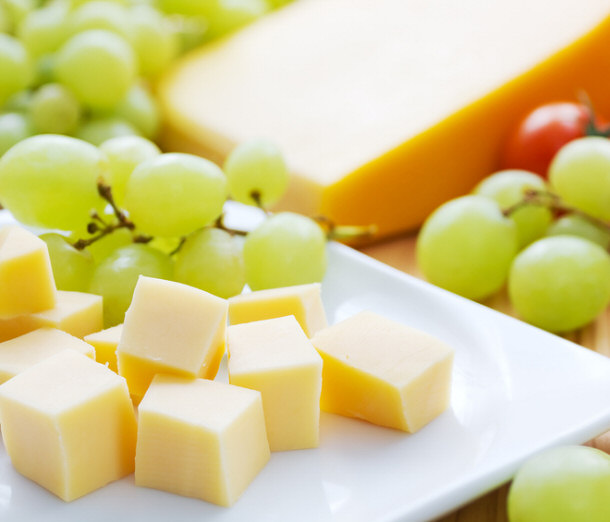
People were surprised by the quality of the cheese after so many decades. The
cheese maker stated that it was due to the freshness of the ingredients. The
cheese was made from the milk on the same day and that was why it was able to
hold its flavor after all that time. The lot of cheeses was bought by another
local store owner. He decided to sell one ounce of the 40-year-old cheese for
between $10 and $12 each. He sold out of it quickly and still had the
34-year-old cheese, which became the oldest edible cheese.
1) The Biggest
Cheese Producer
Worldwide the cheese market is over $55 billion dollars strong and the U.S. is
the largest cheese producer in the world. Australia and New Zealand used to be
strong contenders but are both experiencing tough times due to high feed costs
and adverse climates. While the U.S. is the largest cheese producer, China and
India cheese consumption is experiencing double digit increase thanks to
increasing wealth and urbanization.
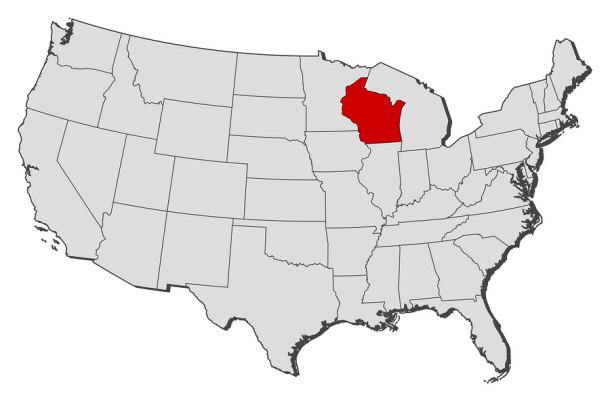
But you can't talk about cheese production without mentioning Wisconsin. The
Badger State produced 2.8 billion pounds of cheese in 2012. That's a whopping
25.4 percent of the nation's cheese production. California was second at 20.7
percent in 2012.
General Food
15 Little Known Facts About McDonald’s
15 Surprising Facts About the History of Fast Food
15 Fascinating Facts about Mushrooms
Top 10 Must-Try Foods of France
Top 15 Foods of the Future
15 Fascinating Facts in the World of Cheese
15 Little Known Facts in the World of Cotton Candy
15 Interesting Facts About Burgers
19 Ridiculous Food Challenges Around the World
15 Unusual Things People Around the World Eat
10 Enthralling Facts about the World of Gourmet |